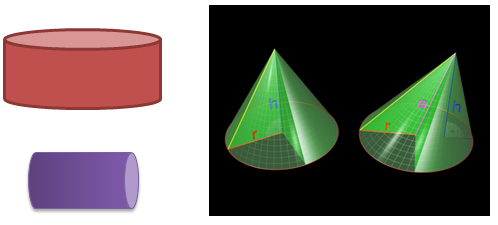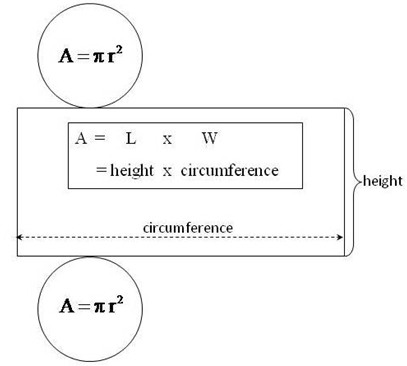Lateral surface area is the combined areas of the lateral faces or surfaces of a solid figure, or the total surface area without the area of the bases.
Note: Technically speaking, faces of a 3-dimensional figure are polygonal regions. Recall that polygons are:
- Closed figures
- Do not have curved edges
- Planar regions (i.e., they are flat)
Observe in the diagrams of cones and cylinders below that the lateral surfaces aren’t polygonal regions at all! Therefore, we cannot call them “faces” of the cone or cylinder. Instead, we call them lateral surfaces.

Source: Illustrations of geometrical cones, Dominique Toussaint
Answer the Following Questions
- If lateral surface area is the “side” of the cylinder, the lateral surface area is just the area of the ___?___.
Interactive popup. Assistance may be required.
Check Your Answer
- If the formula for total surface area of a cylinder is
S = 2πr2 + (dπ · height) or S = 2πr2 + (2rπ · height), what would the formula for the lateral surface area be?
Interactive popup. Assistance may be required.
Check Your Answer
The figure below illustrates the different parts of a cylinder, the net. The two circles are the bases; therefore, their areas would not be included in the formula for the lateral surface area.

Example: A company wants to order 50 cardboard shipping tubes from Rappin’ Wrappers who makes cylindrical cardboard tubes for shipping maps and other large documents. When constructing containers with open ends, they allow an additional 5% of material for the extra material needed to overlap the seams where the tubes are glued together.
The 50 cardboard shipping tubes measure 4 inches in diameter and are 28 inches long, how much material will Rappin’ Wrappers order if the shipping tubes are open on both ends?
 To solve this problem, first draw and label a figure:
To solve this problem, first draw and label a figure:
Drag the dimensions from below onto the appropriate place in the figure.
Answer the Following Questions
- In this problem Rappin’ Wrappers is going to find the___?___ of the tubes.
Interactive popup. Assistance may be required.
Check Your Answer
- The formula for lateral surface area is ___?___ .
Interactive popup. Assistance may be required.
Check Your Answer
- The diameter of a shipping tube is ___?___ and the height is ___?___.
Interactive popup. Assistance may be required.
Check Your Answer
- The lateral surface area of one tube is ___?___ .
Interactive popup. Assistance may be required.
Check Your Answer
- The lateral surface area for 50 tubes is ___?___.
Interactive popup. Assistance may be required.
Check Your Answer
In order to seal the tubes the company needs 5% more material. There are two ways to find the extra percentage of materials. Choose one of the following ways to find the percentage and total amount of material needed.
- Find 5% of the lateral surface area. Interactive popup. Assistance may be required.
Check Your Answer
Add the 5% to the lateral surface area of the 50 tubes. Interactive popup. Assistance may be required.
Check Your Answer
- Since the total amount will be 105% of the lateral surface area of the 50 tubes, find 105% of the lateral surface area.
Interactive popup. Assistance may be required.
Check Your Answer
The company orders the material in either square feet or yards instead of square inches. Determine the materials needed in square feet.
- To find the number of square feet needed, divide the above answer by

- The amount of material needed in square feet is ___?___ .
Interactive popup. Assistance may be required.
Check Your Answer
Determine the materials needed in square yards.
- To find the number of square yards needed, divide the original answer by

- The amount of material needed in square yards is ___?___ .
Interactive popup. Assistance may be required.
Check Your Answer
- The company is trying to decide if they need the ends of the tubes. If it takes 20,735 sq in of material to create 50 shipping tubes with ends, how much less material is needed when ends are not needed?
Interactive popup. Assistance may be required.
Check Your Answer
- If the cost for the materials is $0.25 per square inch, how much would the company save if they did NOT put ends on their tubes?
Interactive popup. Assistance may be required.
Check Your Answer





![]() To solve this problem, first draw and label a figure:
To solve this problem, first draw and label a figure:












